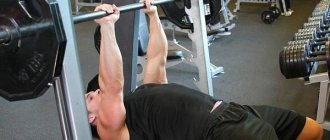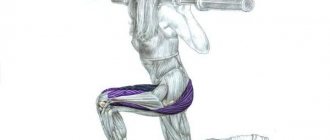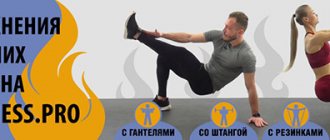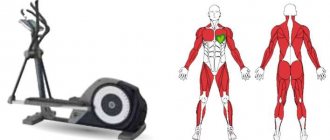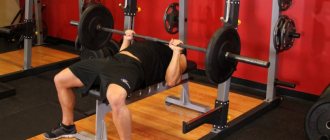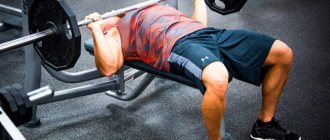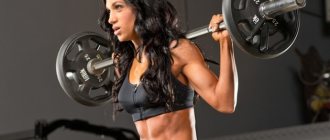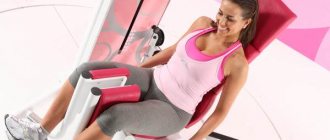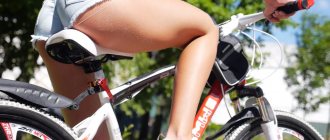Advantages and disadvantages
Experts in heavy training note that the hummer, in fact, has only one significant drawback: this simulator cannot be adjusted to the individual characteristics of the athlete’s figure.
But the main advantage of the hummer is that the mechanism used to develop the simulator helps reduce the likelihood of injuries.
This can be clearly seen when comparing two types of exercises, for example, the barbell bench press and the hummer bench press:
- the hummer allows you not to overstrain the joint, forcing it to also hold the load in an upright position;
- the simulator prevents the load from swinging, which frees up the stabilizer muscles;
- the hammer helps distribute the load evenly on both sides, but free weights can “walk.”
Some bodybuilders even complain that they oversize one side to the detriment of the other. They can only advise one thing - a hummer, in which it is impossible to deviate from an already verified trajectory.
If an athlete feels uneven development of his muscles, then he can correct this deficiency in a lever simulator.
Some people think that the machine does not help build muscle mass, but this is not a drawback. Athletes traditionally build muscle with barbells or dumbbells. But when the stage of grinding the reliefs comes, the hummer is irreplaceable.
Based on the above, it becomes clear: the hummer will be the best assistant for people who are not involved in professional bodybuilding. If you just need to develop your chest, maintain beautiful muscle volume, and develop the strength of your pectoral muscles, then don’t pass by the hummer.
It is quite important to remember the safety guarantees that the hummer provides: when bench pressing, the load will not fall on your chest or face - the hummer is equipped with a special bar that secures the load.
Bodybuilders strive to work to failure in the literal sense, and if the athlete’s muscles come to this state, the athlete will not drop the load on himself.
The hummer is designed in such a way that plates from a barbell are used as a load, and in other devices, for example, roller ones, a system of weights built into the mechanism is used. In these machines, the weight is lifted through a winch. Movement through a winch places uneven loads at different points, and lever mechanisms compensate for this disadvantage.
Three steps
To begin with, I sketched out a small three-point diagram for myself. The first is analytical. Here you need to wiggle your brain and determine exactly what exactly does not suit you. The chest may lag behind in various parameters. Maybe she lacks overall “mass”, or maybe there is no balance - the top lags behind the bottom, or the internal areas of the pectorals are poorly developed... Personally, I had no “mass”, no top, no bottom, no normal internal and external drawing. When you have established what needs to be fixed, look for exercises that will help solve the problem. This is the second step. And finally, the third step is to give your all to the complex that you have compiled for yourself. It seems that everything is simple, but I know in advance that some people will have difficulties with such a scheme. There are people who look at themselves and see that their breasts are somehow unsightly, but they don’t understand what exactly needs to be corrected. Such people need to turn to an experienced friend for advice. The second step is also difficult. All bodybuilders have different anatomy, so there is no single way to correct one or another deficiency. You need to experiment with exercises to choose exactly those options that work best. But the most difficult thing is, of course, the third point. You not only need to be able to give your best, but also use your brains in order to correctly integrate a new complex into your regular training program. I'll explain what's going on here. If the chest does not grow, then the most obvious explanation is that the load from it, due to its anatomical features, is “taken away” by other muscles - triceps, deltoids, small muscles of the upper back... So you need to think carefully about how to correctly create a split so that you don’t start chest training with “fresh” triceps and tired pecs. In this case, the load balance will again shift in favor of extraneous muscles. There are other problems too. How often should you train your chest and with what intensity should you perform exercises for other muscle groups? It may happen that when you press hard on your chest, the total energy expenditure during the week's split will exceed your recovery capabilities. As a result, the remaining muscles will begin to melt like butter in a frying pan. It may be different. You work too hard, “pumping” other muscles, and therefore you have too little physical and mental strength left for your chest. Then there is no need to expect any return. In short, you need to think and think... Personally, for me there were no problems with the first and last points. I have gained enough experience and feel my muscles well. But as for the selection of exercises, I had to rack my brains. First, I studied all the literature on “pumping” the pectoral muscles that I could find. I compared the opinions of different champions and figured out what would suit me myself. In addition, I tried every conceivable variation of the well-known exercises with barbells, dumbbells, and pulleys. And this is what I discovered.
Training rules
For the greatest effect from training, you need to pay attention to a number of nuances:
- Keep your back straight, resisting the natural urge to arch at the waist as you move your arms forward.
- If you train while sitting, press your back against the back of the seat. This way, you will prevent the load from being transferred to the back area and reducing the load from the chest area.
- Press your feet to the floor so as not to reduce the load on the pectoral muscles.
- When performing seated presses, make sure that the handles remain at mid-chest level. Otherwise, the neck muscles will be overstrained.
- When performing bench presses, lift the load evenly, without pushing it out as if you were pushing a barbell.
- Exhale as you move up and forward.
Experienced trainer Denis Borisov will tell you about the pros and cons of working out muscles, as well as the rules of training in a hummer simulator, in the video:
Who needs it?
Working with a hammer requires less experience and professionalism than working with a barbell or dumbbells. Working with a hummer is recommended for the following categories of athletes:
- Beginners who find it difficult to handle heavy sports equipment. The hammer will increase muscle strength and also teach you how to perform the exercise correctly. After working with the simulator, a novice bodybuilder will be able to switch to a barbell and build muscle mass.
- Advanced. Considering that the hummer allows you to avoid overstraining the stabilizers, working in the hummer will help experienced bodybuilders get the most out of any workout. This is done in the simplest way: first you need to perform presses with heavy weights without a machine, and then work on them in a hammer.
- After joint or muscle injuries. The hummer allows you to change your body position during training, it is safe and adjusts the load. If you need to protect your health, then a lever exercise machine will help you.
Benefits of Exercise
Horizontal rows specifically target the mid-back. The advantage of the Hammer exercise is that the body is in a fixed position, as a result of which your spine does not feel unnecessary overload. In addition, you can customize the horizontal levers, change the grip, adjust the seat height and thereby shift the emphasis of the resulting load to different areas of the latissimus muscles.
Thus, when performing the movement in the Hammer, you can use different angles and grips to comprehensively work the back muscles. Considering that the spine does not receive excessive axial load, you can use fairly large weights in the exercise.
In the hummer simulator, you can conveniently perform movements with both hands simultaneously, or with each hand in turn. Some athletes prefer to perform the exercise while standing, while resting their free hand on the back of the machine.
The back muscles make up one third of the total muscle volume of the human body, so by incorporating this exercise into your training program, you can achieve noticeable development of your overall figure and gain an athletic appearance.
Before we begin to consider the technique of performing horizontal rows in a hummer, it is worth dwelling on the possible contraindications of the exercise. Despite the fact that there is no load on the intervertebral discs, if you have any problems with the spine, it is recommended to start the exercise only after consulting a doctor. Note that in general, lever deadlifts are a fairly safe exercise.
Bench press
The hammer bench press is a basic exercise that all bodybuilders perform.
What muscles work?
The exercise loads a number of muscles:
- pectoralis major;
- coracobrachial;
- deltoid - anterior bundle;
- pectoralis minor;
- latissimus dorsi muscle;
- serratus anterior, located near the scapula;
- trapezius muscle - lower bundle;
- elbow;
- triceps
Technique
The hummer bench press is recommended for almost all groups of athletes. It must be done correctly:
- Lie down on a bench with your knees bent.
- Inhale and as you exhale, begin the movement.
- Raise the handles, smoothly lift them up from chest level.
- At the top point, pause and fix the position. You should feel the greatest muscle tension.
- Perform the lift 10 times.
Hummer
The hammer press belongs to a group of block exercises that are designed to work different muscle groups. The most important advantage of such exercises is the even distribution of weight on the arms or legs. When squats or working with dumbbells, almost all the same muscles are involved, but with them the result will not be achieved as quickly. In a hummer, the amplitude of movements is fixed in advance, which makes the work easier, but at the same time gives a greater effect.
At first glance, the fixed amplitude seems to be a huge plus, but in fact, for some people it is a slight disadvantage, because it limits the choice of body position. The only thing that the athlete can do on his own is to change the seat height, and the tilt of the arms will remain unchanged in any case. Since this is a block exercise, this deficiency is not considered significant.
There are certain indications for performing the exercise:
- Uneven breast pumping.
- If basic exercises are not enough for a sufficient load.
It is the hummer that will become the very addition that every athlete needs to get a full load.
Seated press
A good exercise for training the pectoral muscles. Unlike the bench press, this is an isolated exercise.
The hummer press allows you to work on each side of the chest separately - the arms move independently.
What muscles work?
In the seated press, the main load is directed to the pectoralis major muscles, but the load vector can vary both from the desire of the athlete and from the design of the simulator, that is, depending on the model.
Essentially, there are three main options to consider:
- The tension on the middle part of the pectoralis major muscle is concentrated if the arms move in a plane perpendicular to the body.
- If the arms move a little higher, the upper chest becomes more tense.
- If your arms move a little lower, your lower chest becomes tense.
In addition, the load falls on the anterior deltoid and triceps muscles.
Technique
Thanks to the design of the hummer, the trajectory of movement is clearly fixed. The exercise should be performed according to the following rules:
- Adjust the seat height to suit your height.
- Sit on a bench.
- Straighten your back, squeeze your shoulders, raise your head, look straight ahead.
- Concentrate on your chest muscles.
- Breathe in.
- Move your arms apart according to their amplitude.
- Do not straighten your arms at the extreme point.
- Fix the pose at the extreme point for a couple of seconds.
- Inhaling, bring your hands together.
You need to perform the exercise 10-15 times, making 3-4 approaches.
Peculiarities:
- Pay attention to the smoothness of movement - jerking should not be allowed.
- In the extreme position, you should feel a stretch in the pectoral muscles.
- Remember to breathe evenly.
Shoulder press
The hummer is also convenient for working out deltoids.
What muscles work?
In this type of press, the main load falls on the deltoid muscle, as well as on the muscles of the chest and arms. The exercise is performed while sitting.
Muscles involved:
- anterior deltoid;
- middle deltoid;
- supraspinatus muscle;
- trapezoidal;
- serratus anterior;
- biceps;
- triceps
Technique
Working out the shoulder muscles in a hummer is a fairly simple level, suitable even for beginner athletes.
It should be performed according to the following rules:
- Prepare the simulator - choose the weight that suits you.
- Sit on the exercise machine bench, spread your knees, taking a stable position. Place your feet on the floor.
- Grab the handles of the machine.
- Tighten your abs, chest and shoulder muscles.
- Take a deep breath.
- Raise your head.
- As you exhale, straighten your elbows, pressing the handles of the exercise machine.
- Having reached the top point, fixate for a couple of seconds, feeling the tension in all muscles.
- As you inhale, return the handles to their original position.
Perform hummer shoulder presses 15 times in 3-4 sets.
The video shows the technique of performing a press for the shoulder muscles using an example of an exercise on the anterior deltoid muscle. Ivan Gutorov shows:
Leg press
The hammer allows the bodybuilder to change the direction of the load, pumping exactly the muscle that needs it. Control of the emphasis depends on how the athlete places his feet on the platform.
The machine leg press is almost the same as a squat, but much easier on the knees and Achilles tendon. It is important that only in a hummer it is possible to relieve excess tension in the back. This allows the athlete to take more weight, but not risk his health.
What muscles work?
This exercise actively loads the thigh muscles and buttocks, as well as other leg muscles, but not so actively. When performed correctly, part of the load falls on the abdominal area.
Technique
To perform this type of press, you must follow the rules:
- Set a weight that is appropriate for your fitness level.
- Sit on the seat, straighten your shoulders, raise your head.
- Place your feet on the platform so that the load is directed to the muscle group that needs to be worked.
- Remove the supports from the platform.
- Bend your knees to an angle of 90 degrees.
Tips for implementation
An important feature of the exercise is that while pulling the handles of the exercise machine towards the body, the biceps muscles are additionally loaded. The more you emphasize the load on the biceps, the less it will be on the latissimus dorsi muscles.
However, the biceps are a smaller muscle group than the back, so they will get tired sooner. The result is a situation in which you no longer have the strength to perform deadlifts, and the latissimus muscles have not received the necessary load. To avoid this, you need to pull not with your hands, but as if pulling with your elbows, concentrating on the work of the back muscles and try to exclude the biceps from work as much as possible. The ability to feel the work of the desired muscle comes with training and experience, thanks to which professional athletes can effectively concentrate on the work of the target muscle and achieve excellent results
The more you emphasize the load on the biceps, the less it will be on the latissimus dorsi muscles. However, the biceps are a smaller muscle group than the back, so they will get tired sooner. The result is a situation in which you no longer have the strength to perform deadlifts, and the latissimus muscles have not received the necessary load. To avoid this, you need to pull not with your hands, but as if pulling with your elbows, concentrating on the work of the back muscles and try to exclude the biceps from work as much as possible. The ability to feel the work of the desired muscle comes with training and experience, thanks to which professional athletes can effectively concentrate on the work of the target muscle and achieve excellent results.
As already mentioned, the load shifts when the trajectory and direction of traction changes. In the case of waist rows, the upper sections of the latissimus dorsi muscles are worked out more, and in the case of waist rows, their middle sections are worked out.
Modern gyms have Hammer-type machines that allow you to do both horizontal and vertical rows. The vertical row is an exercise similar to the wide-grip pull-up and lat pull-down. All of these exercises are aimed at developing the “width” of the latissimus muscles, although, of course, their “thickness” also develops.
By doing regular back muscle training, you not only work on the appearance of your figure, improving its proportions, but also strengthen your spine and correct your posture, thereby benefiting the health of your body as a whole.
Execution options:
- Lever pull in the simulator with both hands at the same time.
- Lever pull in the simulator with each hand separately.
- Lever traction in the simulator using vertical handles.
Mistakes when performing horizontal rows on the machine
- Try not to excessively lean your body back while performing the bar pull.
- Do not straighten your elbows completely. To maintain tension in the back muscles, your arms should be slightly bent at the elbows.
- Do not turn your head from side to side during the exercise, direct your gaze forward;
- When performing deadlifts, you do not need to hit the plates on the floor, and also do not throw the handles on the supports of the machine.
- When performing the exercise with each hand in turn, keep the body in a fixed position, do not turn the top of the body to the side.
Are there any contraindications?
Healthy people should not have problems working in a humvee, but it is still advisable to consult a sports doctor about training.
Presses in a machine, which is commonly called a hammer press, are part of the training for experienced athletes - both bodybuilders and other sports. But the hummer is also recommended by specialists and those who have just begun their journey to a beautiful and healthy body.
Add a comment Cancel reply
You must be logged in to post a comment.

